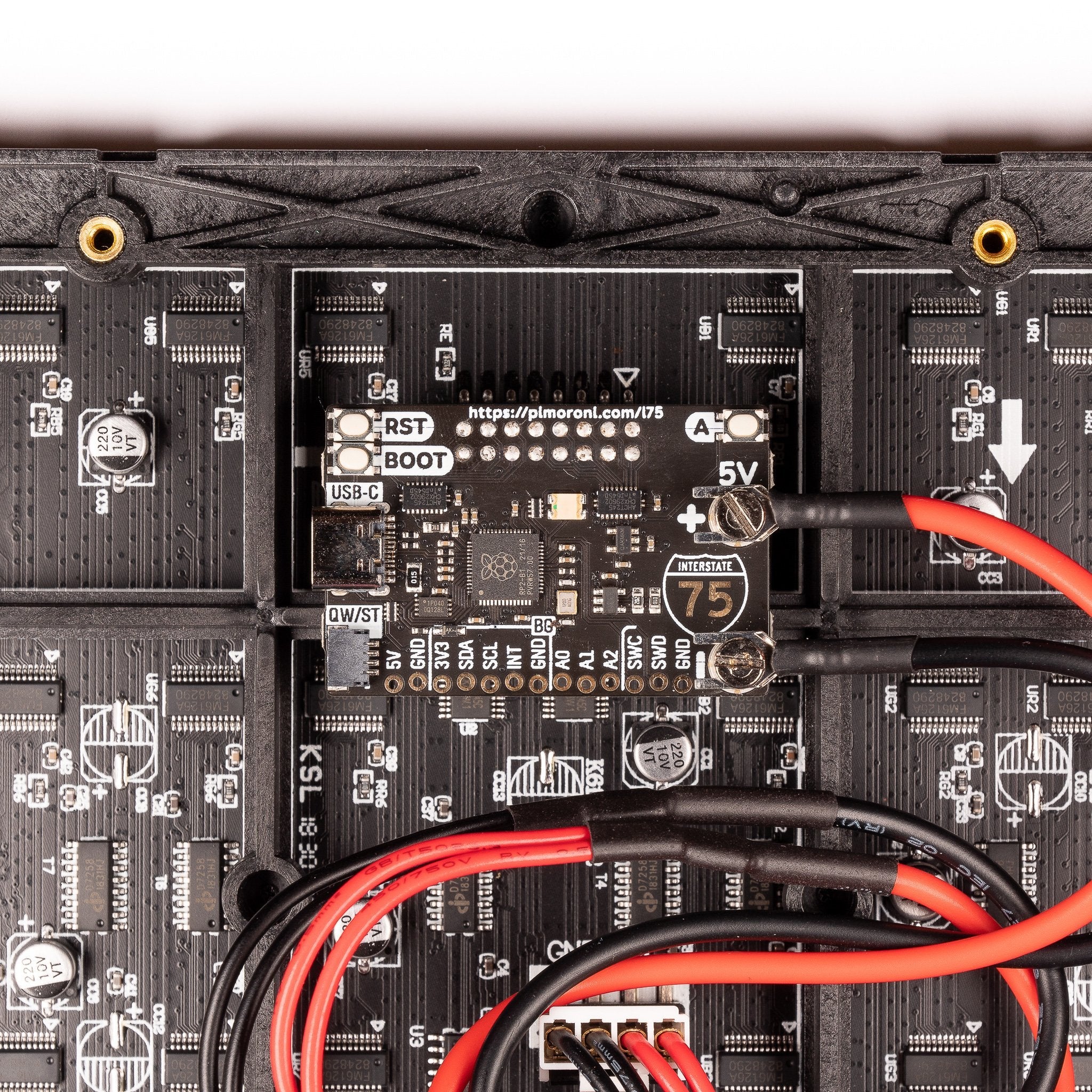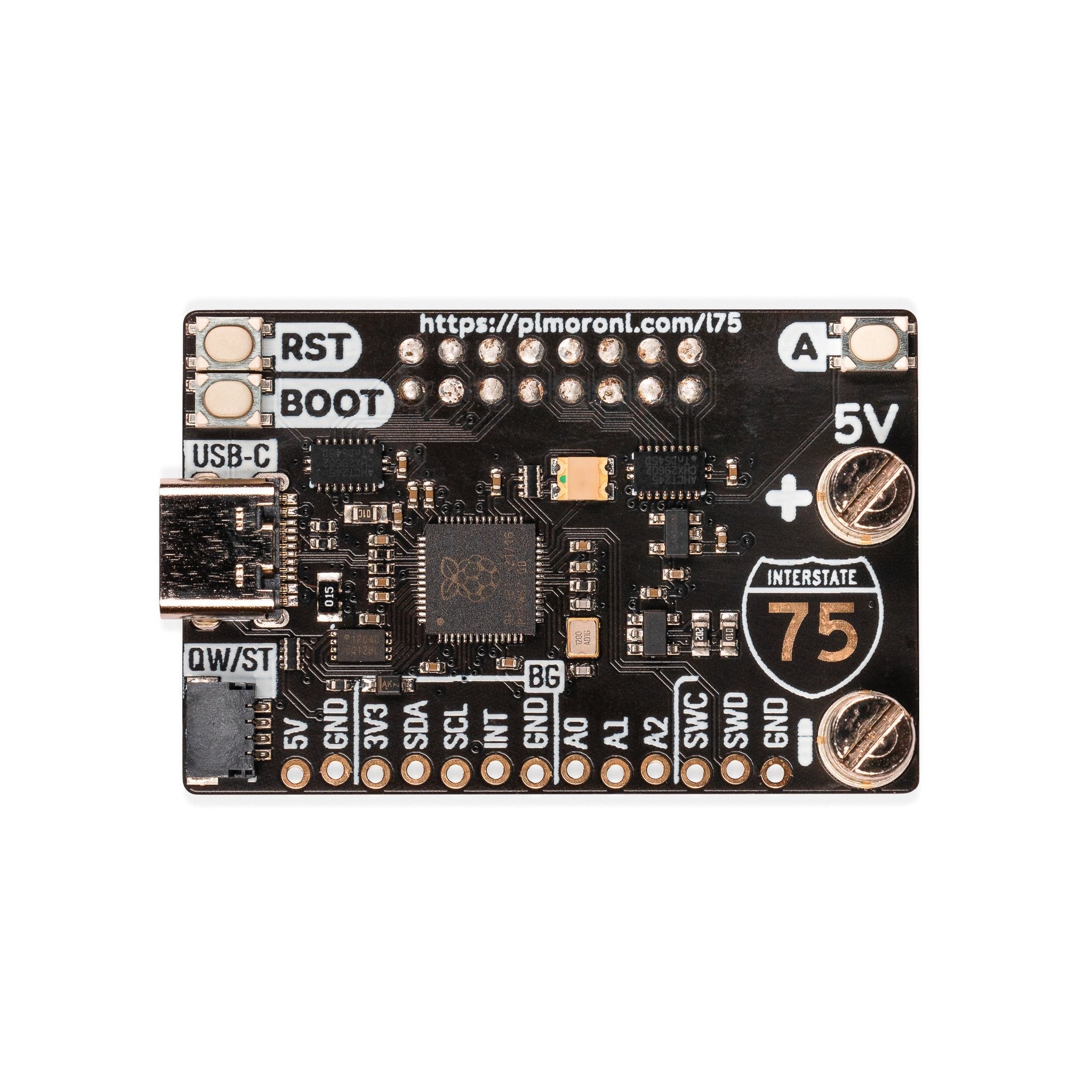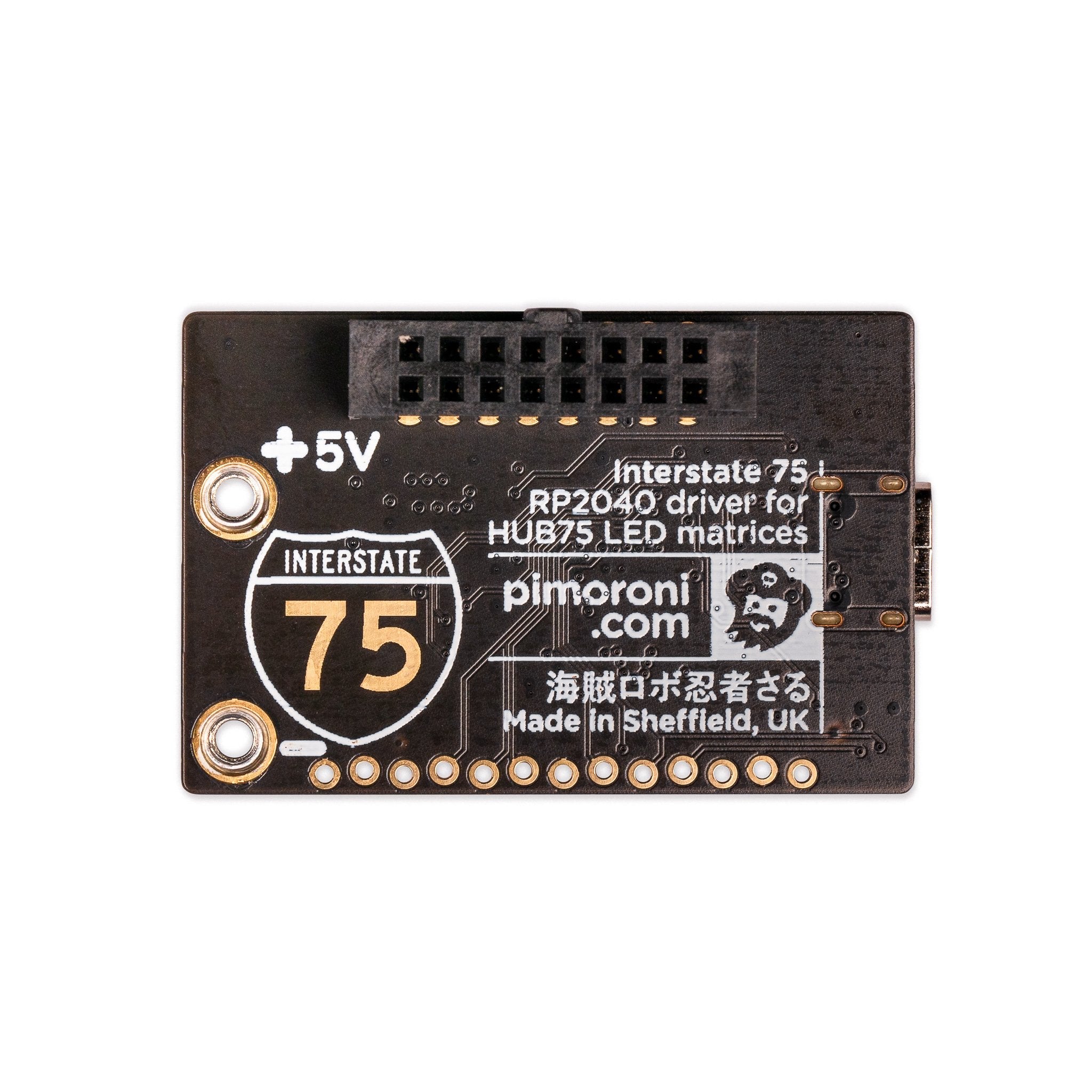Betreten Sie die (LED-)Matrix mit diesem All-in-One-Controller mit USB-C-Stromversorgung für HUB75-Panels.
Die Interstate 75 ist eine RP2040-basierte Treiberplatine für LED-Matrizen des Typs HUB75 . Es ist so konzipiert, dass es problemlos in die Rückseite eines LED-Panels eingesteckt werden kann und bietet eine schnelle und einfache Möglichkeit, eine rollende Beschilderung oder eine auffällige LED-Anzeige für Sensorausgänge zu erstellen.
Die Stromversorgung und Programmierung der Interstate 2040 erfolgt über USB-C. USB-C ist in der Lage, bis zu 3A Strom zu liefern, was genug sein sollte, um ein einzelnes 64x64 (oder kleiner) Panel zu betreiben, vorausgesetzt, es ist nicht zu augenbetäubend hell. Wenn Sie mehr Strom benötigen (vielleicht um mehrere Panels miteinander zu verbinden?), können Sie es stattdessen über die Schraubklemmen betreiben. Außerdem gibt es zwei nützliche Tasten eine Reset-Taste und eine eingebaute RGB-LED .
Pimoroni hat auch eine QW/ST-Anschluss um das Einstecken zu vereinfachen Qwiic oder QT STEM Ausbrüche.
Eigenschaften
- RP2040 (Dual Arm Cortex M0+ mit bis zu 133Mhz und 264kB SRAM)
- 2 MB QSPI-Flash mit Unterstützung für XiP
- Kompatibel mit 32x32, 32x64 und 64x64 LED-Matrizen.
- Stabile Schraubklemmen für die Stromversorgung der LED-Panels.
- USB-C-Anschluss für Stromversorgung und Programmierung (max. 3 A)
- Qw/ST (Qwiic/STEMMA QT) Anschluss
- Reset, BOOT und eine Benutzertaste (die BOOT-Taste kann auch als Benutzertaste verwendet werden)
- RGB-LED
- Vollständig montiert (kein Löten erforderlich)
- Abmessungen: ca. 48,5 x 31 x 17 mm (L x B x H, einschließlich Stecker)
- Schematische Darstellung
- C++/MicroPython-Bibliotheken
LED-Matrix-Paneele und Kabel sind separat erhältlich.
Software
Da es sich um ein RP2040-Board handelt, ist die Interstate 75 firmwareunabhängig! Sie können es mit C/C++, MicroPython oder CircuitPython programmieren.
Pimoronis C++/MicroPython Bibliotheken enthalten einige schicke HUB75-Treiber, die die PIO-Zustandsmaschinen und DMA des RP2040 nutzen, um die CPU-Auslastung zu minimieren und die üppige, gammakorrigierte Farbtiefe von 10 Bit zu maximieren.
Die beste Leistung erhalten Sie, wenn Sie C++ verwenden, aber wenn Sie ein Anfänger sind, empfehlen wir Ihnen, Pimoronis MicroPython-Build zu verwenden, das in den Batterien enthalten ist, um Ihnen den Einstieg zu erleichtern.
- Erste Schritte auf der Interstate 75
- MicroPython der Piratenmarke herunterladen
- Interstate 75 Funktionsreferenz
- C++ Beispiele
- MicroPython-Beispiele
Sie verwenden CircuitPython auf Ihrer Interstate 75 verwenden! Da die CircuitPython-Treiber für eine Reihe verschiedener Mikrocontroller ausgelegt sind, erhalten Sie nicht die ausgefallenen RP2040-Architektur-spezifischen Tweaks, die Sie in Pimoronis Bibliothek finden, aber Sie erhalten Zugang zu Adafruits mächtiger DisplayIO-Bibliothek, die es super einfach macht, alle möglichen Arten von Text anzuzeigen, Formen zu zeichnen und Bilder darzustellen.
- Erste Schritte auf der Interstate 75
- CircuitPython für die Interstate 75 herunterladen
- Erste Schritte mit CircuitPython
- RGB-LED-Matrizen mit CircuitPython
Bitte beachten Sie, dass einige weniger verbreitete Varianten von 64x64-Panels, z.B. solche, die den FM6126A-Chip verwenden, derzeit nicht von CircuitPython unterstützt werden.
Verbinden von Breakouts
Wenn Ihr Breakout einen QW/ST-Anschluss auf der Platine hat, können Sie es direkt mit einem JST-SH auf JST-SH Kabel verbinden oder Sie können jedes von Pimoronis I2C-Breakout-Garden-Breakouts einfach mit einem verwenden JST-SH auf JST-SH Kabel gekoppelt mit einem Qw/ST auf Breakout-Garten-Adapter .
Eine Liste der Breakouts, die derzeit mit Pimoronis C++/MicroPython-Build kompatibel sind, finden Sie in den aktuellen Versionshinweisen.
Außerdem hat Pimoroni eine Reihe nützlicher I2C-Pins, Analog-Pins und Debug-Pins an der Seite des Boards angebracht, an die Sie z. B. Breakouts oder analoge Potentiometer direkt anlöten können.
Über RP2040
Der RP2040-Mikrocontroller des Raspberry Pi ist ein Dual-Core ARM Cortex M0+, der mit bis zu 133 MHz läuft. Er verfügt über 264kB SRAM, 30 Multifunktions-GPIO-Pins (einschließlich eines vierkanaligen 12-Bit-ADC), einen Haufen Standardperipheriegeräte (I2C, SPI, UART, PWM, Taktgeber usw.) und USB-Unterstützung.
Ein sehr interessantes Merkmal des RP2040 sind die programmierbaren IOs, die es Ihnen ermöglichen, benutzerdefinierte Programme auszuführen, die GPIO-Pins manipulieren und Daten zwischen Peripheriegeräten übertragen können - sie können Aufgaben auslagern, die hohe Datenübertragungsraten oder ein präzises Timing erfordern, was traditionell eine Menge Arbeit für die CPU bedeutet hätte.
English Description
Enter the (LED) matrix with this all-in-one, USB-C powered controller for HUB75 panels.
Interstate 75 is a RP2040-based driver board for HUB75-style LED matrices. It's designed to plug neatly into the back of a LED panel, and provides a quick and easy way to whip up some scrolling signage or an eye-catching LED display for sensor outputs.
Interstate 2040 is powered and programmable by USB-C. USB-C is capable of providing up to 3A of power which should be enough to power a single 64x64 (or smaller) panel, assuming you're not planning anything too eye-bleedingly bright. If you need more power than that (so you can chain multiple panels together, perhaps?) you can inject it into the screw terminals instead. There's also two useful buttons, a reset button and an onboard RGB LED.
Pimoroni has also popped a QW/ST connector on there, to make it super easy to plug in Qwiic or STEMMA QT breakouts.
Features
- Powered by RP2040 (Dual Arm Cortex M0+ running at up to 133Mhz with 264kB of SRAM)
- 2MB of QSPI flash supporting XiP
- Compatible with 32x32, 32x64 and 64x64 LED matrices.
- Sturdy screw terminals for powering the LED panels.
- USB-C connector for power and programming (3A max)
- Qw/ST (Qwiic/STEMMA QT) connector
- Reset, BOOT and a user button (the BOOT button can also be used as a user button)
- RGB LED
- Fully-assembled (no soldering required)
- Measurements: approx 48.5 x 31 x 17mm (L x W x H, including connectors)
- Schematic
- C++/MicroPython libraries
LED matrix panels and cables are sold separately, check out the extras tab for some options!
Software
Because it's a RP2040 board, Interstate 75 is firmware agnostic! You can program it with C/C++, MicroPython or CircuitPython.
Pimoroni's C++/MicroPython libraries contain some spiffy HUB75 drivers that use RP2040's PIO state machines and DMA to minimise CPU usage and maximise luscious, 10-bit gamma corrected colour depth.
You'll get best performance using C++, but if you're a beginner we'd recommend using Pimoroni's batteries included MicroPython build for ease of getting started.
- Getting Started with Interstate 75
- Download Pirate brand MicroPython
- Interstate 75 function reference
- C++ examples
- MicroPython examples
You can also use CircuitPython on your Interstate 75! Because CircuitPython drivers are designed to work on a bunch of different microcontrollers you won't get the fancy RP2040-architecture specific tweaks that you'll find in Pimoroni's library, but you will get access to Adafruit's mighty DisplayIO library which makes it super easy to display all sorts of different kinds of text, draw shapes and display images.
- Getting Started with Interstate 75
- Download CircuitPython for Interstate 75
- Getting Started with CircuitPython
- RGB LED Matrices with CircuitPython
Please note that some less-common varieties of 64x64 panels, like ones that use the FM6126A chip, are not currently supported in CircuitPython.
Connecting Breakouts
If your breakout has a QW/ST connector on board, you can plug it straight in with a JST-SH to JST-SH cable, or you can easily connect any of Pimoroni's I2C Breakout Garden breakouts with a JST-SH to JST-SH cable coupled with a Qw/ST to Breakout Garden adaptor.
You can find a list of which breakouts are currently compatible with Pimoroni's C++/MicroPython build in the most recent release notes.
Pimoroni has also broken out a bunch of useful I2C pins, analog pins and debug pins along the side of the board so you can solder things like breakouts or analog potentiometers directly to them.
About RP2040
Raspberry Pi's RP2040 microcontroller is a dual core ARM Cortex M0+ running at up to 133Mhz. It bundles in 264kB of SRAM, 30 multifunction GPIO pins (including a four channel 12-bit ADC), a heap of standard peripherals (I2C, SPI, UART, PWM, clocks, etc), and USB support.
One very exciting feature of RP2040 is the programmable IOs which allow you to execute custom programs that can manipulate GPIO pins and transfer data between peripherals - they can offload tasks that require high data transfer rates or precise timing that traditionally would have required a lot of heavy lifting from the CPU.
Sicherheitsangaben
- Lesen Sie die Bedienungsanleitung sorgfältig durch, bevor Sie das Produkt verwenden.
- Stellen Sie sicher, dass alle Montage- und Installationsanweisungen des Herstellers sorgfältig befolgt werden.
- Verwenden Sie das Produkt nur für den vorgesehenen Zweck.
- Die unsachgemäße Nutzung dieses Produkts kann zu schweren Verletzungen oder Sachschäden führen.
- Nicht für Kinder unter 10 Jahren geeignet.
- Bei unsachgemäßer Verwendung besteht eine Verletzungsgefahr.
- Dieses Produkt entspricht den geltenden Sicherheitsanforderungen der Europäischen Union.
- Dieses Produkt wurde gemäß der GPSR geprüft, die sicherstellt, dass alle relevanten Sicherheitsanforderungen für Konsumgüter eingehalten werden.
Nachverfolgbarkeitsinformationen
Jedes Produkt verfügt über eines oder mehrere der folgenden Merkmale:
- Ein CE-Kennzeichen, das die Einhaltung der Sicherheits-, Gesundheits- und Umweltschutzanforderungen der Europäischen Union anzeigt.
- Eine eindeutige Serien- oder Chargennummer, um die Nachverfolgbarkeit zu gewährleisten und bei Bedarf Rückrufaktionen zu unterstützen.
- Hersteller- und Importeurangaben für den Kundensupport und Sicherheitsanfragen.
Überwachung und Berichterstattung von Vorfällen
Für den unwahrscheinlichen Fall eines Produktproblems haben wir Verfahren implementiert, um:
- Kundenbeschwerden zeitnah bearbeiten.
- Schwerwiegende Vorfälle über das EU Safety Gate/RAPEX-System melden.
- Mit den Marktüberwachungsbehörden zusammenarbeiten, um die öffentliche Sicherheit zu gewährleisten.
Kontakt:
- Email: support [@] pi3g.com
- Telefon: 0341 / 392 858 40
Dieses Produkt ist vollständig mit allen geltenden EU-Vorschriften konform, um die Sicherheit unserer geschätzten Kunden zu gewährleisten.




